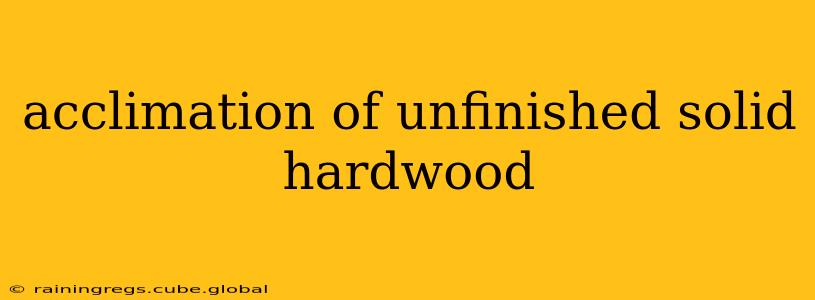Choosing solid hardwood flooring is a significant investment, promising beauty and durability for years to come. However, before installation, understanding the crucial process of acclimation is paramount. Failing to properly acclimate your unfinished solid hardwood can lead to significant problems down the line, including cupping, crowning, shrinking, and gaps appearing between boards. This comprehensive guide will equip you with the knowledge to acclimate your hardwood correctly, ensuring a beautiful and long-lasting floor.
What is Acclimation?
Acclimation is the process of allowing unfinished solid hardwood to adjust to the temperature and humidity levels of its intended installation location. Wood is a hygroscopic material, meaning it absorbs and releases moisture based on the surrounding environment. If you install hardwood that hasn't had time to adjust, the fluctuating moisture content in your home will cause the wood to expand and contract, resulting in the aforementioned problems.
How Long Does Acclimation Take?
The acclimation period typically lasts 7-10 days, but this can vary depending on several factors:
- Wood Species: Different wood species react differently to humidity changes. Some species are more stable than others.
- Thickness of the Wood: Thicker boards generally require a longer acclimation time.
- Climate: A dry climate might require a shorter acclimation period than a humid one.
- Packaging: The way the wood is packaged can affect acclimation. Properly stacked wood with air circulation will acclimate faster.
Where Should I Acclimate My Hardwood?
The ideal location for acclimation is the room where the hardwood will be installed. This ensures the wood is exposed to the precise temperature and humidity conditions it will experience after installation. The space should be at its normal temperature and humidity levels, ideally within the range recommended for hardwood flooring.
If acclimating in the intended room isn't feasible, choose a similar location within the home. Avoid areas with extreme temperature fluctuations, such as near heating or cooling vents, or direct sunlight.
How Should I Stack the Hardwood?
Proper stacking is crucial for effective acclimation. Here's what you should do:
- Stack Horizontally: Lay the boards horizontally, not vertically, to allow for even moisture absorption.
- Leave Space Between Stacks: Ensure there's ample space between stacks to allow for air circulation.
- Unpack Completely: Remove the wood from its packaging completely; do not leave it in the plastic.
- Cover the Stack (Optionally): In exceptionally dry environments, consider covering the stacked wood with a breathable material like a canvas tarp, to prevent excessive moisture loss.
What if I Don't Acclimate My Hardwood?
Installing un-acclimated hardwood carries significant risks:
- Cupping: The edges of the boards curl upwards.
- Crowning: The middle of the board buckles upwards.
- Gapping: Gaps appear between the boards.
- Shrinkage: Boards shrink and become loose, creating gaps.
- Reduced Lifespan: Improper acclimation can significantly shorten the lifespan of your flooring.
What is the Ideal Humidity Level for Hardwood Acclimation?
The ideal humidity level for acclimation generally falls between 30% and 50%. Using a hygrometer to monitor humidity levels is essential during the acclimation process. You can adjust the humidity in your home using a humidifier or dehumidifier to maintain the optimal range.
What is the Ideal Temperature for Hardwood Acclimation?
The ideal temperature for acclimation is usually between 65°F and 75°F (18°C and 24°C). This range is comfortable for most people and prevents extreme temperature fluctuations that can affect the wood.
Can I Speed Up the Acclimation Process?
While you can't significantly speed up the process, ensuring optimal conditions (proper stacking, suitable environment) will facilitate faster and more even acclimation. Do not attempt to artificially speed up the process using heat or other methods, as this can damage the wood.
Conclusion
Acclimating your unfinished solid hardwood is a crucial step towards a beautiful and long-lasting floor. By following these guidelines, you'll ensure your hardwood adjusts to its new environment, minimizing the risk of problems down the road. Remember, patience is key; taking the time to acclimate your wood properly will pay off in the long run.
